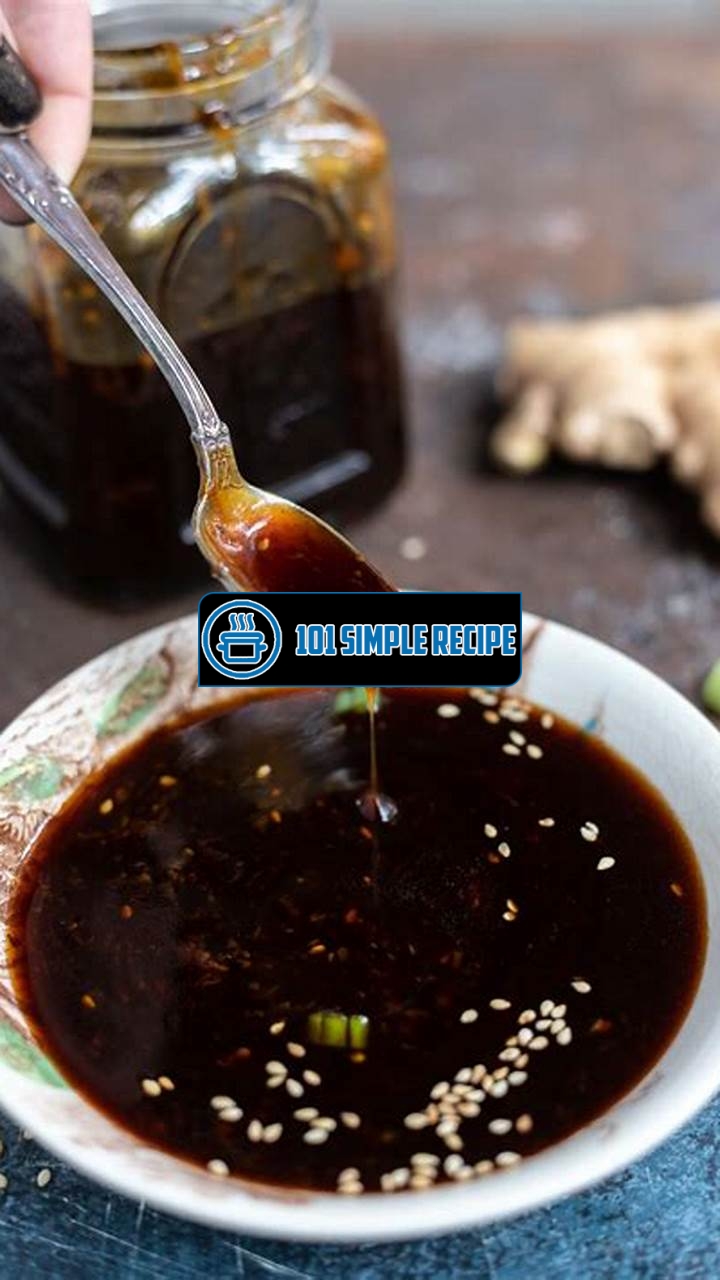Are you looking to add some delicious Asian flavors to your meals? Look no further than this amazing teriyaki sauce recipe! Whether you’re a vegetarian or a meat lover, this sauce is versatile and can be used in a variety of dishes. Say goodbye to store-bought teriyaki sauce and hello to a homemade version that will elevate your meals to a whole new level of deliciousness. In this article, we will share with you the best teriyaki sauce recipe that will bring a burst of flavor to your palate. So, grab your apron and get ready to cook up a storm!

The Origins of Teriyaki Sauce
Teriyaki sauce is a beloved condiment in Japanese cuisine, known for its distinct sweet and savory flavor. Its origins can be traced back to the 17th century in Japan, where it was first developed as a way to preserve and flavor fish. Today, teriyaki sauce is not only used in traditional Japanese dishes but has also become popular worldwide, adding a delightful twist to various cuisines. Let’s delve deeper into the history and cultural significance of this delectable sauce.
The Origin Story of Teriyaki Sauce
The story behind teriyaki sauce begins with the method of cooking called “teri,” which means to glaze or shine, and “yaki,” which refers to grilling or broiling. This combination of techniques gave birth to the mouthwatering teriyaki sauce we know today. Traditionally, fish such as mackerel or salmon was marinated in a mixture of soy sauce, mirin (a sweet rice wine), and sugar before being grilled over an open flame. The sauce would caramelize, creating a shiny glaze that enhanced the flavor of the fish.
Over time, the popularity of teriyaki sauce spread throughout Japan, and the recipe expanded to include other ingredients such as chicken, beef, and vegetables. The marinade became more versatile as different regions added their own unique twists. For example, some variations incorporated ginger, garlic, or sesame oil to enhance the flavor profile. The simplicity and versatility of teriyaki sauce made it a staple in Japanese households and paved the way for its global recognition.
Traditional Ingredients Used in Teriyaki Sauce
The classic recipe for teriyaki sauce consists of a few key ingredients that come together to create its signature flavor. Soy sauce serves as the base ingredient, providing a salty and umami-rich foundation. Mirin, a sweet rice wine, adds a gentle sweetness that balances out the saltiness of the soy sauce. Finally, sugar, often in the form of brown sugar, is added to give the sauce its characteristic caramelized glaze.
Additionally, some variations of teriyaki sauce may include grated ginger or minced garlic to add depth and complexity to the flavor. These aromatic ingredients complement the savory and sweet notes of the sauce. As teriyaki sauce continues to evolve, chefs and home cooks have experimented with incorporating other flavors such as pineapple juice or chili flakes for a unique twist on the traditional recipe.
The Cultural Significance of Teriyaki Sauce
Teriyaki sauce holds a special place in Japanese culture, representing a harmonious balance of flavors. It embodies the concept of umami, the savory fifth taste that is highly valued in Japanese cuisine. The popularity and versatility of teriyaki sauce have made it a symbol of Japanese culinary excellence around the world.
In addition to its culinary significance, teriyaki sauce has also influenced other cultures’ cuisine. It has been adapted and incorporated into various dishes worldwide, adding a touch of Japanese flair and enhancing the flavor profile. From teriyaki chicken in the United States to teriyaki stir-fried noodles in Thailand, the influence of teriyaki sauce extends far beyond its country of origin.
In conclusion, the history and cultural significance of teriyaki sauce highlight its enduring appeal and global impact. From its humble origins as a simple marinade for fish, teriyaki sauce has become a beloved flavor enhancer and a symbol of Japanese culinary traditions. Whether you’re grilling seafood, chicken, or vegetables, adding a delightful glaze of teriyaki sauce is sure to elevate your meal to new levels of deliciousness.
If you’re looking for a quick and easy meal, try our teriyaki shrimp recipe that showcases the tangy flavors of our teriyaki sauce.
The Basics of Making Teriyaki Sauce
Teriyaki sauce is a versatile and flavorful condiment that adds a tasty punch to any dish. Whether you’re grilling meats, stir-frying vegetables, or marinating tofu, this homemade sauce will elevate your meals to new heights. In this section, we will delve into the fundamental components and techniques required to create a delicious teriyaki sauce from scratch.
The Core Ingredients of Teriyaki Sauce
To create the perfect teriyaki sauce, you need to gather the core ingredients that provide the distinct flavors and textures. These ingredients include:
- Soy Sauce : The base of teriyaki sauce is soy sauce, which adds a savory and umami taste to your dish.
- Mirin : Mirin, a sweet rice wine, brings a hint of sweetness to balance the saltiness of the soy sauce.
- Sake : Sake, a Japanese rice wine, adds depth and complexity to the sauce.
- Sugar : Brown sugar or honey provides a touch of sweetness to counter the savory flavors.
- Ginger and Garlic : Freshly grated ginger and minced garlic infuse the sauce with aromatic flavors.
By combining these key ingredients, you can achieve the perfect balance of sweet and savory in your teriyaki sauce.
Mastering the Balance of Sweet and Savory
Creating the ideal balance between sweetness and savoriness is crucial for a delectable teriyaki sauce. To achieve this, you can adjust the quantities of sugar, mirin, and soy sauce according to your preferences. It’s essential to taste the sauce as you go and make adjustments as needed.
If you prefer a sweeter teriyaki sauce, you can increase the amount of mirin or sugar. On the other hand, if you prefer a more savory profile, you can add extra soy sauce or reduce the sweetness by utilizing less sugar.
Remember, the key to mastering the balance of flavors lies in finding the right combination that pleases your taste buds. Experimentation is key, and over time, you’ll discover the perfect ratio for your unique teriyaki sauce.
Techniques for Achieving the Perfect Consistency
Aside from the taste, achieving the perfect consistency of your teriyaki sauce is equally important. The sauce should be thick enough to coat your ingredients but not overly gloopy.
To achieve the desired consistency, you can utilize the following techniques:
- Cornstarch Slurry : Mixing cornstarch with water and adding it to the sauce helps thicken it without altering the flavors.
- Simmering and Reducing : Simmering the sauce over low heat and allowing it to reduce can lead to a thicker and more concentrated consistency.
By combining these techniques and adjusting the cooking time, you can achieve the perfect texture and consistency for your teriyaki sauce.
In conclusion, a delicious teriyaki sauce can take your meals from ordinary to extraordinary. By understanding the basics of making teriyaki sauce, mastering the balance of sweet and savory, and employing techniques for achieving perfect consistency, you’ll be able to create a homemade sauce that enhances the flavors of your favorite dishes.
A Variation of Flavors: Teriyaki Sauce Variants
Teriyaki sauce is a versatile and flavorful condiment that is used in a variety of dishes worldwide. While the traditional Japanese teriyaki sauce is known for its sweet and tangy taste, different regions and cuisines have their own adaptations and flavors. Let’s explore the various teriyaki sauce variants that bring unique taste profiles to meals.
Japanese Teriyaki Sauce: Authentically Sweet and Tangy
Originating from Japan, the authentic teriyaki sauce is a combination of soy sauce, mirin (a sweet Japanese rice wine), and sugar. This classic sauce is known for its perfect balance of sweet and tangy flavors. It not only enhances the taste of grilled or broiled meats but can also be used as a marinade or glaze.
In Japan, teriyaki sauce is often used in dishes like chicken teriyaki, beef teriyaki, and salmon teriyaki. The sauce is cooked until it thickens and coats the meat, creating a delightful glaze. The sweetness of the mirin complements the savory soy sauce, while the sugar adds a touch of caramelization.
Japanese teriyaki sauce is a must-try for those who enjoy the authentic flavors of Japan. Its sweet and tangy taste brings a unique twist to any dish.
American Teriyaki Sauce: Infused with Additional Ingredients
In the United States, teriyaki sauce has been adapted to suit the American palate. While the basic ingredients remain the same, American teriyaki sauce often includes additional ingredients to enhance its flavor. Some popular additions include garlic, ginger, honey, and pineapple juice.
This Americanized version of teriyaki sauce adds a depth of flavor and complexity to dishes. The garlic and ginger provide a hint of spiciness, while the sweetness from honey and pineapple juice balances the overall taste. This sauce pairs well with chicken, beef, shrimp, or even vegetables.
️ The American teriyaki sauce with its added ingredients brings a little heat and sweetness to your meals, giving it a distinct and flavorful twist.
Exploring Global Teriyaki Variations
Beyond Japan and the United States, teriyaki sauce has found its way into various cuisines around the world. Each region adds its own ingredients and flavors, resulting in interesting and unique teriyaki variations.
In Hawaii, for example, teriyaki sauce is infused with the flavors of the islands. It often includes ingredients like pineapple, sesame oil, and brown sugar, giving it a tropical and slightly caramelized taste. This Hawaiian teriyaki sauce is commonly used in dishes such as teriyaki chicken bowls and grilled seafood.
️ Exploring global teriyaki variations allows you to experience diverse flavors and culinary traditions. Each variation brings its own twist, making teriyaki sauce a truly global condiment.
Whether you prefer the authentic sweetness of Japanese teriyaki sauce or the bold flavors of American adaptations, teriyaki sauce is a versatile and delicious addition to any meal. From Japan to Hawaii and beyond, the different teriyaki sauce variants showcase the adaptability and creativity of chefs worldwide.
Note: Get creative and experiment with your own teriyaki sauce recipe by combining different ingredients and flavors. The possibilities are endless!
For more delicious recipes, check out our teriyaki beef recipe which pairs perfectly with our teriyaki sauce recipe.
Teriyaki Sauce in Everyday Cooking
Discover the versatile uses of teriyaki sauce in everyday meals and how it can elevate your culinary creations. Teriyaki sauce is a popular Japanese condiment that has become a staple in kitchens around the world. Its unique blend of salty, sweet, and savory flavors adds a delightful twist to any dish. Whether you’re grilling meats, stir-frying vegetables, or marinating seafood, teriyaki sauce can take your cooking to the next level.
Marinades and Glazes: Enhancing Meat and Seafood
One of the main applications of teriyaki sauce is as a marinade or glaze for meat and seafood. The rich flavors of soy sauce, brown sugar, ginger, and garlic in teriyaki sauce work wonders in tenderizing and flavoring proteins. You can marinate chicken, beef, or pork in teriyaki sauce for a few hours or overnight to infuse them with a delicious umami taste. When grilling or baking, brush the meat with teriyaki sauce to create a caramelized glaze that adds depth and complexity to the final dish.
If you’re a seafood lover, teriyaki sauce can work wonders for fish, shrimp, or even scallops. Marinate the seafood for about 30 minutes, then sear, bake, or grill for a succulent, flavorful seafood experience. The natural sweetness of teriyaki sauce complements the delicate taste of seafood, resulting in a harmonious and satisfying dish.
Stir-Fries and Noodle Dishes: Adding a Flavourful Touch
Another way to incorporate teriyaki sauce into your everyday cooking is by adding it to stir-fries and noodle dishes. The umami-rich sauce can transform a plain stir-fry into a burst of flavors. To create a teriyaki stir-fry, simply sauté your favorite vegetables, protein, and noodles in a hot pan. Towards the end, add a generous amount of teriyaki sauce and toss everything together. The sauce will coat the ingredients, infusing them with its distinctive taste.
Teriyaki sauce also works well as a finishing touch for noodle dishes. Drizzle some sauce over cold noodles or toss cooked noodles in teriyaki sauce for a quick and delicious meal. The sweetness of the sauce adds a delightful contrast to the savory notes of the noodles.
Vegetarian and Vegan Options with Teriyaki Sauce
For vegetarians and vegans, teriyaki sauce offers a wide range of options to enhance plant-based meals. Tofu is a perfect canvas for teriyaki sauce, as it soaks up the flavors beautifully. Coat tofu slices or cubes with teriyaki sauce and bake or pan-fry until crispy on the outside and tender inside. The result is a delightful mix of textures and tastes that will satisfy even the most discerning palates.
You can also use teriyaki sauce to elevate vegetable dishes. Simply stir-fry your favorite veggies and drizzle teriyaki sauce over them to infuse them with a burst of flavor. From broccoli and carrots to snow peas and mushrooms, teriyaki sauce adds depth and excitement to any vegetable medley.
In conclusion, the versatility of teriyaki sauce in everyday cooking is truly remarkable. Its ability to enhance the flavors of meat, seafood, vegetables, and even tofu makes it a must-have ingredient. Experiment with different recipes and let the teriyaki sauce work its magic in your kitchen. Your taste buds will thank you! ️
To add a twist to your next barbecue, try our teriyaki chicken recipe made with our homemade teriyaki sauce for a flavorful and juicy dish.
The Health Benefits of Teriyaki Sauce
Teriyaki sauce, with its bold and savory flavors, not only enhances the taste of your dishes but also provides several health benefits. Incorporating teriyaki sauce into your meals can contribute to a healthy and balanced diet. Here are some reasons why teriyaki sauce can be a nutritious choice:
Low-Fat and Low-Calorie Options
If you are conscious about your calorie intake or watching your weight, teriyaki sauce offers a low-fat and low-calorie alternative to other sauces. Traditional teriyaki sauce is made with a base of soy sauce, which is naturally low in fat. By using reduced-sodium soy sauce and limiting the amount of sugar added to the recipe, you can create a healthier version of teriyaki sauce with fewer calories and less fat. This makes it a great option for individuals who want to enjoy flavorful meals without the guilt of consuming excess calories or unhealthy fats.
A Source of Essential Nutrients
Teriyaki sauce contains several essential nutrients that can support your overall health. Soy sauce, a key ingredient in teriyaki sauce, is rich in amino acids, iron, and B vitamins. Amino acids are the building blocks of protein and play a vital role in various bodily functions, including muscle growth and repair. Iron is necessary for the production of red blood cells, which carry oxygen throughout the body. B vitamins are essential for energy production, brain function, and the metabolism of nutrients. By incorporating teriyaki sauce into your meals, you can boost your nutrient intake and support your body’s optimal functioning.
Considerations for Special Dietary Needs
Whether you follow a specific dietary regimen or have food allergies or sensitivities, teriyaki sauce can be adapted to meet your requirements. For individuals following a gluten-free diet, you can use gluten-free soy sauce as a base for your teriyaki sauce recipe. Additionally, if you have a soy allergy, you can substitute soy sauce with alternative ingredients like coconut aminos or tamari sauce. These options ensure that even individuals with dietary restrictions can enjoy the flavors and benefits of teriyaki sauce. ️
Note: It’s important to read the labels of store-bought teriyaki sauces as they may contain added sugars, preservatives, or artificial ingredients. Making your own teriyaki sauce at home allows you to control the quality of ingredients and customize it to suit your preferences and dietary needs.
In conclusion, teriyaki sauce not only adds a burst of flavor to your meals but also offers several health benefits. With low-fat and low-calorie options, a rich nutrient profile, and adaptability to various dietary needs, teriyaki sauce can be a versatile and nutritious addition to your diet. So go ahead and whip up your own teriyaki sauce, knowing that you are making a healthier choice for your well-being. Enjoy the delicious flavors while reaping the rewards of a balanced and nourishing meal!
Frequently Asked Questions
If you have any questions about making your own teriyaki sauce, we’re here to help. Check out these frequently asked questions:
| No. | Questions | Answers |
|---|---|---|
| 1. | Can I use low-sodium soy sauce for this recipe? | Absolutely! Using low-sodium soy sauce is a great option if you’re watching your sodium intake. |
| 2. | Is it possible to make teriyaki sauce without sugar? | Yes, you can substitute sugar with alternative sweeteners like honey or maple syrup for a healthier version. |
| 3. | Can I use this teriyaki sauce as a marinade? | Absolutely! This teriyaki sauce works wonderfully as a marinade for meats, tofu, or vegetables. |
| 4. | How long does homemade teriyaki sauce last? | If stored properly in an airtight container in the refrigerator, homemade teriyaki sauce can last for up to two weeks. |
| 5. | Can I freeze teriyaki sauce? | Yes, you can freeze teriyaki sauce in a freezer-safe container for up to three months. |
| 6. | What are some variations to the basic teriyaki sauce recipe? | You can experiment with adding ingredients like ginger, garlic, pineapple juice, or sesame oil to customize the flavor of your teriyaki sauce. |
Thanks for Reading!
We hope you enjoyed learning how to make your own teriyaki sauce. Now you can add a burst of sweet and savory flavor to your favorite dishes. Don’t forget to bookmark this page so you can revisit it whenever you want to whip up a batch of homemade teriyaki sauce. Happy cooking!
Jump to Recipe
Teriyaki Sauce Recipe

Learn how to make your own teriyaki sauce at home with this easy recipe. Perfect for adding a burst of sweet and savory flavor to your favorite dishes!
- 1/2 cup soy sauce
- 1/4 cup water
- 2 tablespoons honey
- 1 tablespoon rice vinegar
- 1 clove garlic (minced)
- 1 teaspoon ginger (grated)
- 1 tablespoon cornstarch
- 1 tablespoon cold water
- In a small saucepan, whisk together soy sauce, water, honey, rice vinegar, minced garlic, and grated ginger.
- Place the saucepan over medium heat and bring the mixture to a simmer.
- In a separate small bowl, whisk together cornstarch and cold water until smooth.
- Slowly pour the cornstarch mixture into the saucepan while whisking continuously.
- Continue simmering the sauce for an additional 2-3 minutes, or until it has thickened to your desired consistency.
- Remove the saucepan from heat and let the teriyaki sauce cool before using or storing.






